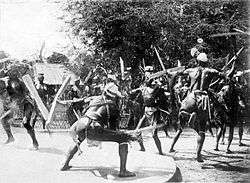Indonesian martial arts
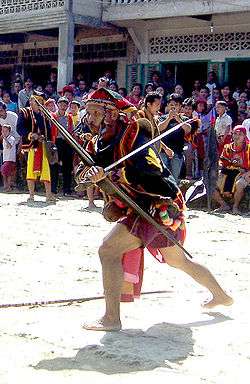
Indonesian martial arts refers to the variety of fighting systems native to or developed in the Indonesian archipelago, both the age-old traditional arts, and the more recently developed hybrid combatives. In the Indonesian language the term bela diri (lit. self-defense) is used to mean martial art, and in essence the Indonesian fighting arts are meant as one's defence against perceived threat and assault. Other than physical training, they often include spiritual aspects to cultivate inner strength, inner peace and higher psychological ends.[1]
Today, Indonesian martial arts are synonymous with pencak silat. Indeed, the term was coined as an umbrella term to refer for a class of related martial arts originating in the Indonesian archipelago.[2] Nevertheless, a number of fighting arts in Indonesia are not included within the category of silat. Western misconception links silat with "jungle tribes" but in actuality, pencak silat was neither created nor traditionally practised by Indonesia's tribal inhabitants, many of whom have unique martial arts of their own. Some of these fighting traditions has been developed into a complete fighting system (e.g. pencak silat and tarung derajat) with set of combative rules, styles and disciplines; while others are practised as ritual battle, mock combat to just as a war dance (e.g. cakalele and caci).
History
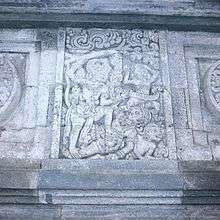
The archipelagic realm that is today Indonesia was the scene of warfare among the native populace for much of its long history, and the people of the region naturally developed effective methods of combat and self-defense.[1] The earliest weapons found in Indonesia were spears, single-edge swords, shields, and axes. Indonesian tribes also familiar with natively-developed edged weapons, such as parang, klewang, mandau, badik, pedang, kujang, golok and kris. The martial activity in Indonesia started as tribal warfare among Indonesian tribes. Mostly motivated by various factors; such as to gain lands, to take over natural resources, acquiring slaves from neighbouring village, tribal ways to settle disputes, to coming of age rituals of certain tribal custom, such as headhunting. Indonesian tribes such as Dayak, Nias and Batak are known to practice the headhunting rituals.
Numbers of Indonesian ethnic groups has developed traditional war dances, which reenacted some stylized fighting movements. Examples include sword dance of Nias people, war dances of Batak, Dayak, Papuan and Torajan people, to Minahasan kabasaran dance and Balinese baris dance.
The Indonesian natives began to develop and formulate various style of combat and self-defence systems. Archaeological findings revealed that the origins of Pencak Silat dates back to the sixth century, to the times of the Srivijaya empire on Sumatra and also the 13th century Majapahit empire in East Java. Artifacts showed that this unique combat system had been used consistently through Indonesia's history.[3]
Systems
Some of Indonesian fighting traditions has been developed into a complete fighting systems, completed with set of rules, disciplines, ranks, costumes and gears.
Pencak Silat
Pencak silat is a compound of the two most commonly used words for martial arts in Indonesia. Pencak was the term used in central and east Java, while silat was used in Sumatra and Borneo. In modern usage, pencak and silat are seen as being two aspects of the same practice. Pencak is the essence of training, the outward aspect of the art. Silat is the internal essence of combat and self-defense, the true fighting application of the techniques.[4] The earliest evidence of pencak silat is in 6th-century Riau from where it saw further development under Indian and Chinese influence in the Hindu-Buddhist kingdoms of Sumatra and Java. The art gradually spread throughout most of what is now Indonesia and reached its peak in the medieval Majapahit kingdom. Generalizations of silat techniques are difficult due to the diversity of systems. Any part of the body is used and subject to attack. Strikes, grabs, locks, and weapons are all incorporated. Training is often supplemented with internal methods of development such as meditation.
Kuntao
Kuntao is a Hokkien term for martial arts, in this case referring to those practised by the Tionghoa Chinese community of the Indonesian archipelago. Kuntao has a long history in the region dating back to ancient times. Such has been the influence between kuntao and pencak silat that the terms are used interchangeably in some styles. Every Chinese community in Indonesia either has or historically had some style of kuntao, but they were not taught openly until the latter half of the 20th century. Northern and southern Chinese martial arts are represented in kuntao, both from the external and internal schools. Some systems were directly imported from China and underwent little or no changes, such as thaikek (taiji), pakua (baguazhang or eight-trigram palm) and peh-ho (baihequan or white crane fist). Other popular systems originate from the same states as the Chinese communities who practice them, so that Fujian, Shandong, Kongfu and Guangdong styles dominate.
Fitimaen
Fitimaen is an indigenous form of stick-fighting from Buru in the Maluku Islands. The term comes from the Buru word maen which means stick. The maen are either made from rattan or from native hardwood, of which there are hundreds of varieties.[5] Sparring sessions are short to minimise injury, and training is carefully conducted for the same reason. They may be fought with one or a pair of sticks, the length of which depends on personal preference. The first written attestation of fitimaen comes from a British naturalist who recounts that the natives are "adepts at quarterstaff" and that even children "practice with singular skill their cuts and thrusts". While spears and metal knives were also used by the Buru people for fighting, their preference has always been the fighting staff. Donn F. Draeger calls them the best stick and staff fighters in the whole of Indonesia although not a particularly combative community. The blowpipe (sumping) and bow and arrow could also be used for warfare but are generally hunting implements. Two styles of fitimaen are dominant, one from Namlea and the other from Leksula.[5]
Tarung Derajat
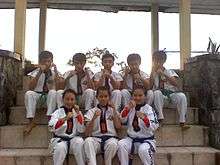
Tarung Derajat is a full body contact martial art from Bandung city in West Java, created by Haji Achmad Dradjat. Developed in the 1960s, it is a hybrid system which incorporates boxing, grappling and street fighting.[6] Tarung Derajat is officially recognized as a national sport and used as a basic training by Indonesian Army. Tarung Derajat emphasizes punching and kicking, but is not limited to these, as grappling and sweeping are also included in its training method. Its practitioner is called Petarung, which translates to "fighter" in English.
Since the 1990s, Tarung Derajat has been refined for combative sport. In 1998, the Tarung Derajat organization officially became a member of KONI. Since then, Tarung Derajat has a spot in Pekan Olahraga Nasional, a national multi-sport competition held every four years. Tarung Derajat main association KODRAT (Keluarga Olahraga Tarung Derajat) now has sub-organizations in 22 provinces in Indonesia. It was introduced as an exhibition number in the 2011 Southeast Asian Games in Palembang, Indonesia.[7]
Related practices
Some of Indonesian ethnic groups has developed their own martial traditions as part of their rituals and festival. However, most of these fighting traditions has not been developed into a complete fighting system yet. There are no exact combative rules, styles and disciplines; mostly are practised as ritual battle, mock combat to just as a war dance.
Payuq or Bebintih
Payuq or Bebintih is a traditional Dayak wrestling, especially native to Kenyah people of East Kalimantan province in Indonesia. In the Dayak Kenyah language, payuq means "physical fights", and it has become a tradition passed down through generations held annually as a ritual during harvest festival. Payuq is a wrestle match among two men, the match aimed to put each other down, to lift and slammed the opponent. Physical strength and technique is a deciding factor of a Payuq match.
The identical traditional wrestling in neighboring Kutai region is called Bebintih which means "mutual tackle". The wrestling match usually performed in dried rice paddies after being harvested and the round circle is set on the center of the field as the ring. Bebintih match was done by two men with both shoulders pushed against each other, while their hands holds the opponent's loincloth, and then mutually tackle and fight using their legs and lower body. The winner is the one that successfully knock his opponent or push to the outside of the circle. Such regulations is similar to a Japanese Sumo match.[8]
Sisemba
Sisemba, also known as semba or sempak, is a kick-fighting activity practised by the Toraja of South Sulawesi province. Native to the Batan and Pangalla areas in North Toraja, it is today mainly seen in the Toraja cultural centre of Rantepao. The ritual of mass kick-fighting is usually performed as part of the rice harvest festival in Tana Toraja villages. According to Toraja tradition, the sisemba mass kick-fighting — which usually performed on harvested rice paddies, is a prerequisite for the next successful harvest.[9]
In the practice of sisemba, hundreds of participants from two villages (traditionally only male) join hands and form lines of two or more people. They may be linked by the arms or by clasping hands. The line is not necessarily straight but may take the form of a V-shape, an inverted V-formation, a wedge, a circular arc either concave or convex, or any other shape. Once joined in line, all participants must be linked except the men on the ends of each line. Once the opposing ranks come within range, they kick at each other in an attempt to knock players out of the opponent's line.[9] A divided line is then overwhelmed by the superior numbers of the opposing line, who maneuvre and surround stragglers. Smaller lines are however capable of more agile manoeuvres, such as sending the player at the end of a line flying through the air completely off the ground, and then pulling them back in a whip-like manner after they've struck the opponent. Any sort of kicks are allowed and any part of the body may be targeted so long as the link to the line is maintained. An individual who has been knocked out of line may get up and rejoin their line; until rejoining he is off-limits to the attacks of the opposing team. In earlier days, such an individual would be kicked into submission or until unconscious.
Sisemba originated as a form of mass defence in which every man in the village repelled invaders. It was also used as a way of settling disputes between kampung. Victory was obtained simply by reducing the numbers of the opposing team through injury. Today it is a harvest-time festivity. Matches last for several hours each day over a period of weeks during the harvest season. The winner is decided based on the superiority of technique but injuries are still frequent, particularly to the face. To ensure that the match runs smoothly, the village elders act as supervisors. If a participant or a pair of them was deemed to be too violent, and the fight might led to intensely dangerous duel, the village elders will separates them from the crowd, and they are not allowed to continue to participate further in sisemba.[9]
Cakalele
The cakelele is a male war-dance practised by the aboriginals of North and Central Maluku. Hybrid forms also exist in Sulawesi, Timor, and the Tanimbar Islands. Mentioned in native legends, it originated as a way for the warriors to celebrate after a successful raid. From the age of sixteen, village boys would study and work for 3–5 years with the kakehan the men's secret society. The art of combat formed part of their education, as was the cakalele. While not an actual martial art, the dance has preserved some techniques and the full range of aboriginal weaponry, making it greatly important in the study of Indonesia's native fighting methods. Backed by the rhythm of the drum and gong (tifa) and fife (sulin), two opposing captains engage in mock-combat with a spear (sanokat) and long knife (lopu). Supporting warriors wield long knives and a narrow wooden shield known as salawaku.[10][11]
Kabasaran
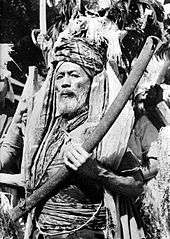
Kabasaran is a Minahasan war dance from North Sulawesi, performed by several men, cladded in red costume. The kabasaran dancers daily work as farmers or guards in the villages. But if their village are in danger of being attacked by the enemy, the dancers will turn into waranei or local warriors.[12]
According to Minahasan tradition, waranei or warrior is hereditary status inherited from a father to his son for generations. Each kabasaran dancer also must have a weapon which is also inherited from generations.[12] In general, the basic structure of the dance consists of nine kabasaran dance moves (jurus) using sword (santi) or nine moves using spear (wengkouw), also the stances which consists of two steps to the left, and two steps to the right. The dance is accompanied by percussion instruments such as gongs, drums or kolintang called Pa 'Wasalen, while the dancers are called kawasalan, which means "dancing by imitating the movement of two fighting roosters".[12]
Caci
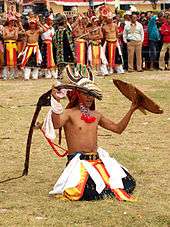
The caci is the warrior's whip dance practised by the native men of Manggarai Regency, Flores, East Nusa Tenggara province. Although often describes as a traditional dance, the practice seems to be more like a ritual fighting than a choreographed dance. The men that perform the ritualistic whipping dance are cladded in traditional costume, equipped with Japanese samurai-like masked headgears, rattan whips (tereng or agang) and shield (nggiling). The dancers are bare-chested and wear pants covered by sarung songke, Manggarai's embroidered sarongs. Their lower backs are adorned with small jingling bells. The masks are made of buffalo hide wrapped in colourful cloths, with horn-like headgear meant to protect the fighter dancers from flogging, along with head-cloths worn over the face.[13]
The name of the dance is composed of two Manggarai words: Ca, which means "one", and Ci, which means "test". Thus, the Caci is a one-on-one test between men. Participants of the dance must be agile, good fighters, able to sing local songs and physically fit.[14] The performers are divided into two groups that alter their positions as offence and defence. Caci is always played by the host group (ata one) and a challenger group from another village (ata pe'ang or meka landang). Caci performers also sing and exchange quatrains while flogging each other. The ritual is usually performed in the yard of a communal house. Injuries are common for caci performers, and the wounds are believed will heal in a few days. According to local beliefs; if the back of the body gets whipped, there will be a good harvest. The blood dripping from the wound constitutes an offering to ancestors for soil fertility. Injuries and bruises due to flogging are sustained by caci performers, and are considered as the symbol of bravery, masculinity and tribal pride. According to local tradition, the caci ritual originated in local folklore, telling that in the remote past there were two brothers who owned a buffalo. When the younger brother fell into a deep hole, the older brother had to slaughter the buffalo to get its skin to help his sibling escape the hole.[13]
Mageret pandan
The mageret pandan or makare-kare or commonly known as "Pandan battle" is a Balinese ritualistic fight using a sharp and thorny pandan club as the weapon. The weapon solely used in this battle is a 15 centimetres club, made by tying together 10 to 15 pandan (Pandanus amaryllifolius) leaves, which are edged by tiny, sharp thorns. The ritual is practised by Balinese Aga population of Tenganan village in Karangasem Regency, about 70 kilometres east of Denpasar. Tenganan is one of the few surviving Bali Aga villages, the people of Tenganan worship Indra as their highest god. In ancient Vedic scriptures, Indra is known as the patron god of warriors, the god of war, hence many major religious festivals in Tenganan involve a ritualistic battle. This ritualistic battle was meant to honour the ancestors as well as honouring the gods. According to Tenganan tradition, the mageret pandan is compulsory for Tenganan men. The adults view the battle as a way to pay tribute to their ancestors, while the children treat it as a way to test their courage; children as young as seven have participated.[15]
Weapons
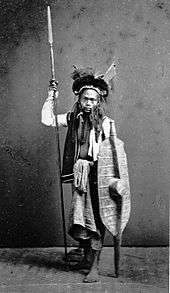
- Badik: a knife or dagger developed by the Bugis and Makassar people of southern Sulawesi
- Cabang: short-handled trident, literally meaning "branch"
- Cambuk/Pecut: whip, might be made from various materials; rattan, bamboo, fabrics, leather to stingray's tail
- Celurit/Sabit: a sickle, commonly used in farming, cultivation and harvesting of crops.
- Kerambit/Kuku Macan: a blade shaped like a tiger's claw
- Kipas: traditional folding fan preferably made of hardwood or iron.
- Klewang: a type of single-edge longsword with a protruding notch near its tip.
- Kris: a dagger, often with a wavy blade made by folding different types of metal together and then washing it in acid.
- Kujang: Sundanese blade roughly shaped like a deer's antler.
- Parang/Golok: machete or broadsword, commonly used in daily tasks such as cutting through forest brush.
- Pedang: sword, either straight or curved
- Rencong/Tumbuk Lada: slightly curved Aceh and Minang dagger, literally meaning "pepper crusher".
- Samping/Linso: piece of silk sash fabric worn around the waist or shoulder, used in locking techniques and for defence against blades.
- Sundang: a double edge Bugis sword, often wavy-bladed
- Tameng/Perisai: shield made of hardwood, weaved rattan, or sometimes metal.
- Tombak/Lembing: spear or javelin made of bamboo, steel or wood that sometimes has horsehair attached near the blade.
- Toya: rod or staff made from wood, steel or bamboo.
- Trisula: a trident or 3-pronged spear
In popular culture

Indonesia has showcased its martial arts in cinema, novels, comics, and TV series for decades. In Indonesian literature, which includes novel and comic books, there is a genre called silat, it is not necessarily solely featuring silat discipline, as books featuring Chinese kungfu stories are also included within silat genre. Indonesian cinema has a genre called laga which translate to "fight" or "action". This genre was especially made popular in 1980s due to the popularity of radio drama show of historical epic themes; such as Saur Sepuh, Tutur Tinular and Misteri Gunung Merapi, mostly featuring pencak silat fights set in ancient Indonesian kingdoms such as Pajajaran and Majapahit as the background. (c. 14th to 15th century).
While they have always had a following in neighbouring Malaysia and Singapore, it was the 2009 film Merantau that brought international attention to pencak silat. The film had a mostly positive reaction from cinema critics[16] and generated enough interest for the lead actor to follow up with The Raid: Redemption in 2011 which received international acclaim. Its sequel The Raid 2: Berandal was similarly well-received but drew much criticism for its extreme gore,[17][18] leading to the film being banned in Malaysia.[19]
See also
References
- 1 2 "Pencak Silat: Techniques and History of the Indonesian Martial Arts". Black Belt Magazine. Retrieved 6 July 2015.
- ↑ Donn F. Draeger (1992). Weapons and fighting arts of Indonesia. Rutland, Vt. : Charles E. Tuttle Co. ISBN 978-0-8048-1716-5.
- ↑ "Silek Harimau Minangkabau: the True Martial Art of West Sumatra". Wonderful Indonesia. Retrieved 8 July 2015.
- ↑ Howard Alexander, Quintin Chambers, Donn F. Draeger (1979). Pentjak Silat: The Indonesian Fighting Art. Tokyo, Japan : Kodansha International Ltd.
- 1 2 Draeger, Donn (1992). Weapons & Fighting Arts of Indonesia (Tuttle martial arts ed.). Tuttle Publishing. ISBN 978-1-4629-0509-6. Retrieved 11 November 2015.
- ↑ Agnes Winarti (13 November 2011). "Tarung derajat looking for bigger stage". The Jakarta Post. Jakarta. Retrieved 11 November 2011.
- ↑ "Tarung Derajat Tampil di SEA Games 2011". Tempo.
- ↑ Suryadi Gunawan. "'Payuq', 'Bebintih' Roh Para Pegulat Kaltim di Ajang Internasional". Antara News.com (in Indonesian). Retrieved 11 November 2015.
- 1 2 3 Husain (4 May 2012). Glori K. Wadrianto, ed. "Menyaksikan Tradisi "Sisemba" di Toraja Utara". Kompas Travel (in Indonesian). Retrieved 11 November 2015.
- ↑ P. E. De Josselin De Jong (1984). Unity in Diversity: Indonesia as a Field of Anthropological Study. Foris Publications. ISBN 90-6765-063-3.
- ↑ Albert G Van Zonneveld (2002). Traditional Weapons of the Indonesian Archipelago. Koninklyk Instituut Voor Taal Land. ISBN 90-5450-004-2.
- 1 2 3 "Tarian Kabasaran". Indonesia Kaya (in Indonesian).
- 1 2 Indra Harsaputra (5 April 2013). "Manifesting strength and love". The Jakarta Post. West Manggarai, East Nusa Tenggara. Retrieved 21 September 2015.
- ↑ Markus Makur (25 March 2013). "Caci, the Warrior's Whip Dance". The Jakarta Post Travel. Labuan Bajo, NTT. Retrieved 21 September 2015.
- ↑ Anton Muhajir (18 June 2009). "Ritualistic battle honors the ancestors". The Jakarta Post. Tenganan. Retrieved 21 September 2015.
- ↑ Brown, Todd (23 July 2009). "PiFan 09 Review: MERANTAU". Twitch Film.
- ↑ "Review: The Raid 2 is too gory to stomach". Rediff. 30 May 2014.
- ↑ "Paramedics Called To 'Raid 2' Premiere: 'The Most Violent Mainstream Film Since Passion Of The Christ'". UPROXX.
- ↑ "The Raid 2: Berandal banned due to excessive violence". astroawani.com.
Further reading
| Wikimedia Commons has media related to Martial arts in Indonesia. |
- Quintin Chambers and Donn F. Draeger (1979). Javanese Silat: The Fighting Art of Perisai Diri. ISBN 0-87011-353-4.
- Sean Stark (2007). Pencak Silat Pertempuran: Vol. 1. Stark Publishing. ISBN 978-0-615-13968-5.
- Sean Stark (2007). Pencak Silat Pertempuran: Vol. 2. Stark Publishing. ISBN 978-0-615-13784-1.
- O'ong Maryono (2002). Pencak Silat in the Indonesian Archipelago. ISBN 979-9341-60-4.
- Suwanda, Herman (2006). Pencak Silat Through my eyes. Los Angeles: Empire Books. p. 97. ISBN 978-1-933901-03-9.
- Mason, P.H. (2012) "A Barometer of Modernity: Village performances in the highlands of West Sumatra," ACCESS: Critical Perspectives on Communication, Cultural & Policy Studies, 31(2), 79–90.


